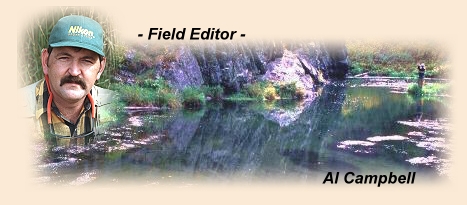|
Somewhere in the west/central area of the Black
Hills a spring is flowing the first signs of life
into a small stream known as Castle Creek. Adding
to this small trickle, other springs contribute
their bounty as the collection of water moves
eastward toward an impoundment called Deerfield
Lake. Humble beginnings for sure, but a lot of
productive streams start this way.
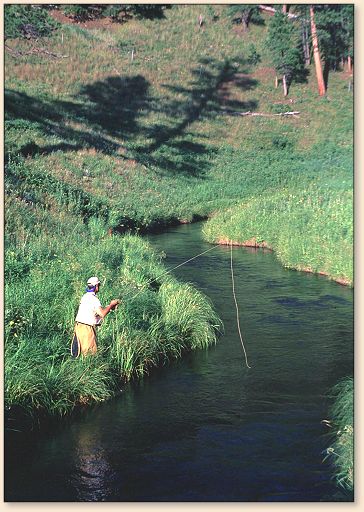
By the time this stream reaches a width no wider
than a long step, it is supporting small brookies
and enough watercress to serve up a tart salad to
the 4th infantry. The watercress supports an army
of scuds, sowbugs and aquatic insects capable of
feeding all the hungry trout that can comfortably
fill the steam. The balance of nature served up
by a cold-water fishery is robust and full of life.
By the time Castle Creek reaches the width of a
good standing jump, brookies big enough to eat
are plentiful and ready to chase down any fly,
ven if it isn't presented in a proper fashion.
Add a foot to the stream's width and you'll find
a few rainbows that migrated upstream from Deerfield
Lake and decided to make that water their summer
home. Although food is plentiful, the best feeding
season is short and the trout can't afford to let
a good meal go downstream; so fishing is rather easy.
That is, if you can cast accurately enough to keep your
fly out of the willows, chokecherries and rosebushes
which shade the creek in many places.
For the most part, Castle Creek above the lake passes
through meadows and pastures on private land. However,
there are public access points complete with parking
lots and walk-though points in the barbed wire fence,
that were put there for fishermen to have full access
to the stream. A short running jump could navigate
the passage from one bank to the other in this area,
so wading is out of the question; but fishing is as
good as you can find, if you don't mind catching fish
less than a foot long. In the springtime when rainbows
are moving upstream to spawn, you might catch a whopper,
but the average fish will not exceed a foot the rest
of the year.
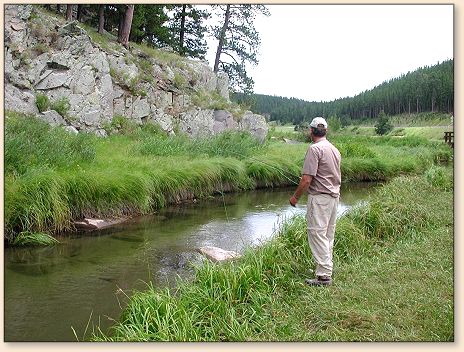
A few hundred yards before Castle Creek empties into
Deerfield Lake, Ditch Creek joins it, nearly doubling
its size and flow. Venturing up Ditch Creek produces
similar fishing you would find along Castle Creek, and
public access is plentiful except in a few areas where
people have homes. Late in the summer, a hopper pattern
on either creek won't float long before it disappears
into the mouth of a hungry fish. You won't find
finicky trout here, but a careless approach to the
stream bank will send fish fleeing to the cover of
overhanging banks.

If you like float tubing, you might think you found
a chunk of heaven in the waters of Deerfield Lake.
Rainbow Trout, splake (a cross between lake trout
and brookies), and brook trout are abundant and
eager. Crayfish are very abundant and in constant
danger if they venture far from the protection of
the rocks they inhabit. Aquatic insect life is
abundant. A variety of wet flies (like the Deerfield
Special) and streamers (especially those that look
like crayfish) will produce hard strikes and strong
fights. These fish average about 10 to 14 inches,
but some are truly big. The state record brookie
(seven pounds) was caught on a black woolly bugger
in this lake. Some of the rainbows and splake get
even bigger, but you won't catch the big guys on
every cast. The biggest fish will be found searching
for crayfish near rocky banks.
Below the dam, you'll find a few brown trout mixed
with the brookies. Here is where the "instant experts"
usually fail in their articles on this creek. The South
Dakota Fish and Game biologists have intentionally kept
brown trout out of the waters above Deerfield Dam, but
several articles I have read by instant experts and
one book writer, list brown trout as inhabitants of
the entire Castle Creek drainage. Brookies, bows
and splake above the lake; and brookies, browns and
a very few bows below the lake, is how the fish are
distributed.
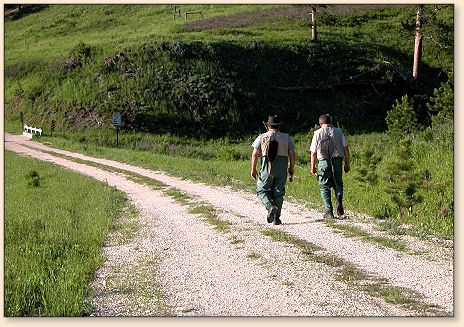
The stream below the lake is a much different fishery
than anything you'll find above the lake. A parking
lot about a mile and a half below the dam, and a
(closed to vehicles) service road provides easy foot
access to the stream, and the fish get picked on by a
fair amount of fishermen during the summer. The fishing
is still good and the brookies are bigger, but not
nearly as easy to fool as they were above the lake.
To put a perspective on it; you might only catch a
couple dozen fish in a day below the lake, but they
will be bigger in size.
Common insect life in this area includes small mayflies
like baetis, callibaetis and PMDs. Several varieties
of caddisflies and small stoneflies can be found here
in the summer, but by August the fish will be looking
for hoppers, especially on windy days. As with most
small tailwater fisheries, the trout can get somewhat
picky about pattern, size and presentation, although
a size 14 or 16 Orange Shwapf is usually a killer the
brookies can't resist. They usually don't tolerate
wading well, so fishing is best done from the bank,
not the middle of the stream. The stream averages
8 to 20 feet in width in this area.
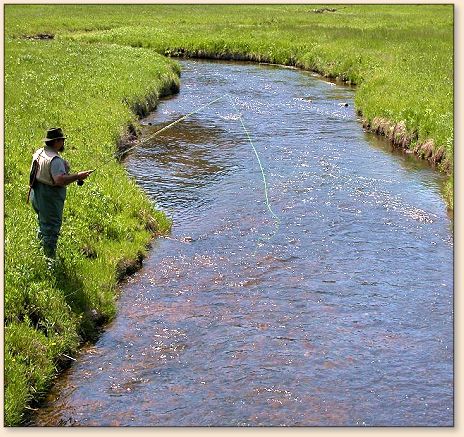
About three miles below the dam, the first of several
streams with discolored water from ancient mining
operations enters Castle Creek. This is where many
fishermen turn around and head back to the parking
lot. This is also where a few of the "instant experts"
who have written about this creek, complained about
tainted water and a damaged fishery. I'm glad they
feel that way. It leaves many miles of excellent
fishing to those of us who don't mind fishing
discolored water that is otherwise fine. It also
means the fish are less disturbed, greater in
numbers, and larger in size. A bonus is the
lack of other fishermen you're likely to see.
From this point downstream to Rapid Creek, the stream
receives less fishing pressure except for the areas
near Castle Peak campground and the old town of Mystic.
The complexion of the creek is more like a freestone
stream than the spring creek or tailwater fishery it
offered upstream. The water flows faster, bigger and
bushier flies work better, and the fish are less
picky about what they eat. The fish are generally
bigger too. Unfortunately, there are more trees
and bushes along the stream-bank to contend with
and steal your flies.
The further downstream from Deerfield Lake you go,
the more browns you'll find in your catch. If you're
only here for brookies, stay close to the dam or move
above it. If your only care is catching fish, choose
your medicine based on the type of fishing you prefer,
and the size of fish you want to catch.
I prefer to fish all of the water. I'm very familiar
with much of the stream, and growing familiar with
the rest of it. It's my home water, and I know
plenty of its secrets. I can point out riffles
that always hold a fish, and great looking pools
that seldom produce a bite. I can point out the
snag where Slicfoot and I caught brookies all
afternoon one day, and the pool where a doctor
from Wisconsin made his first cast into the stream
as I snapped his picture. I can show you where Gus
and Gil first learned some of my secrets of the
stream and where they learned to read it for
better success.

I can do that because I know the stream in ways
the "instant experts" never will. I am intimately
familiar with that stream and its personality to a
level those other guys can't imagine. I have walked
its banks, courted its fish and learned its secrets
in ways that can only be accomplished with time
spent there. It is my playmate, my friend, and
something I call "home water."
~ AC
|
